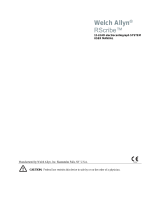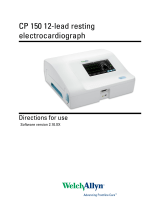Page is loading ...

Welch Allyn
®
RetinaVue
®
100 Imager
Best practices

ii Welch Allyn® RetinaVue® RV100 Imager
© 2018 Welch Allyn. All rights are reserved. To support the intended use of the product described in this publication, the purchaser of
the product is permitted to copy this publication, for internal distribution only, from the media provided by Welch Allyn. No other use,
reproduction, or distribution of this publication, or any part of it, is permitted without written permission from Welch Allyn
Welch Allyn assumes no responsibility for any injury to anyone, or for any illegal or improper use of the product, that may result from
failure to use this product in accordance with the instructions, cautions, warnings, or statement of intended use published in this
manual.
For patent information, please visit www.welchallyn.com/patents.
For information about any Welch Allyn product, or to contact your nearest Welch Allyn representative, go to
http://www.welchallyn.com/en/about-us/locations.html.
Manual DIR 80024126 Ver A
Release date: 2018-11
www.welchallyn.com
Welch Allyn, Inc.
4341 State Street Road
Skaneateles Falls, NY 13153 USA

iii
Contents
Introduction . . . . . . . . . . . . . . . . . . . . . . . . . . . . . . . . . . . . . . . . . . . . . . . 1
About this document . . . . . . . . . . . . . . . . . . . . . . . . . . . . . . . . . . . . . . . . . . . . . . 1
Firewall requirements . . . . . . . . . . . . . . . . . . . . . . . . . . . . . . . . . . . . . . . . . . . . . . 1
Best practices general recommendations . . . . . . . . . . . . . . . . . . . . . . . . . . . . . . 2
Wi-Fi . . . . . . . . . . . . . . . . . . . . . . . . . . . . . . . . . . . . . . . . . . . . . . . . . . . . . . . . . . . 2
Network (TCP/IP) . . . . . . . . . . . . . . . . . . . . . . . . . . . . . . . . . . . . . . . . . . . . . . . . . 2
Other recommendations. . . . . . . . . . . . . . . . . . . . . . . . . . . . . . . . . . . . . . . . . . . . 3
Frequently asked questions . . . . . . . . . . . . . . . . . . . . . . . . . . . . . . . . . . . . . . . . . 4

iv Contents Welch Allyn® RetinaVue® RV100 Imager

1
Introduction
About this document
This document provides supported settings and configurations to allow for the Welch
Allyn® RetinaVue® Imager and the Welch Allyn® RetinaVue® Network Client to properly
connect and send data on a Wi-Fi network. Please see the Welch Allyn medical device
specific user guide for details on configuring the wireless on the device.
Firewall requirements
The RV100 and PC-based clients must be allowed to connect to each of the following
servers through DNS:
Production
• register.retinavue.net
• client.retinavue.net
• retinavue.net
Sandbox – Integration and training
• sandboxregister.retinavue.net
• sandboxclient.retinavue.net
• sandbox.retinavue.net
Settings:
• Allow TCP port 443 (HTTPS/TLS) – Used for RetinaVue Client Application to Customer
Portal
• Bypass or disable web proxy for these servers/addresses – RV100 does not support
web proxy
• Allow ICMP – RV100 tests Internet connectivity by sending an ICMP Echo Request to
IP 8.8.4.4 google-public-dns-b.google.com.

2Introduction Welch Allyn® RetinaVue® 100 Imager
Best practices general recommendations
The following are general best practice recommendations for establishing durable
wireless connections between the device radio and your wireless network.
Wi-Fi
• 2.4 GHz, 802.11 b/g/n, 20 MHz channel
• WPA2-Personal with Pre-Shared Key (password) authentication
• WPA2-Enterprise with PEAPv0/MSCHAPv2 (user name and password) authentication
Network (TCP/IP)
• The RV100 uses only IPv4
• DHCP required, Static IP on RV100 is not supported.
• Ensure that DHCP provides IPv4, Netmask, Default Router (gateway) address and
a minimum of one DNS server address.
Best practice Affected types Without best practice
Signal Strength In areas the device radio is expected to operate the
RSSI Value ≥ -65dBm for wireless signals (measured when 802.11 APs
set to 25mW).
Wireless Dropped packets and loss of connectivity requiring
excessive re-sends due to poor wireless coverage.
Signal to Noise Ratio (SNR) ≥15dB. Wireless High noise level causes dropped packets.
Spanning Tree Protocol (STP) STP should be turned off for the
Welch Allyn specific VLAN/SSID.
Wireless Dropped connections, loss of connectivity resulting
in no data sent or excessive re-send attempts.
WLAN Optimization
• Controller CPU utilization < 40%
• Radio channel utilization < 40%
• Number of SSIDs per AP ≤ 4
• Number of clients per AP ≤ 25
• AP Received packet error rate ≤ 100%.
Hardware,
wireless
When network performance is outside
recommended parameters, potential loss or
corruption of data.
Note
The DNS server address is not displayed on RV100 Network Screen.

Best practices Introduction 3
Other recommendations
Wi-Fi network selection
• Hidden SSID/WLAN
• For non-broadcasting networks, select Other from the list of networks and enter
the SSID/WLAN name manually. WPA2-PSK – Leave the user name blank and
complete the password field.
• Save Credentials - When entering credentials for a new network, make sure that Save
Credentials is checked before exiting the screen.
• Delete a set of stored credentials – Select the network, clear the check box, and click
Save.
• Clicking Save after entering credentials saves (or clears) the credentials but does not
initiate a network connection.
• Click Connect to initiate a network connection.
Wi-Fi Status indicators (icons on the RV100 status bar)
• The signal strength icon ( ) indicates relative signal quality. No bar indicates there
is very poor signal quality.
• The icon means that the camera was not able to communicate with the
RetinaVue Network severs at the time of the exam submission. If the icon
remains on the camera, it means the last attempt to submit an exam was not
successful. See “Q: I am connected to the Wi-Fi and have good signal; why won’t
exams submit from the Review List?” on page 4.

4Introduction Welch Allyn® RetinaVue® 100 Imager
Frequently asked questions
Q: What’s the difference between the Patient List and the Review List?
A: All exams scheduled to the camera that haven’t had images taken remain in the
Patient List.
Once images have been taken for an exam, the exam is either submitted or sent to
the Review List.
Q: Why are exams sent to the Review List?
A: Any exams appearing in this list have not been sent to the RetinaVue Network
Server yet.
This means that the camera did not have a good wireless connection at the time of
submission. The exam will wait in the review list until a good connection is made
before automatically submitting.
Q: I am connected to the Wi-Fi and have good signal; why won’t exams submit from
the Review List?
A: You might have a good connection to your Wi-Fi, but there might be a setting
within your network blocking communication between your camera and the
RetinaVue Network Server. Look for on the camera which might indicate
blocked communication.
Q: Why do I get a “Cannot connect to Server” message on the RV100?
A: The camera may timeout its initial connection attempt after power on, due to the
wireless interface not being ready, which may cause the icon ( ) and the message
Cannot connect to the server to display. Acknowledging the message automatically
clears the problem once the wireless interface is connected.
/









